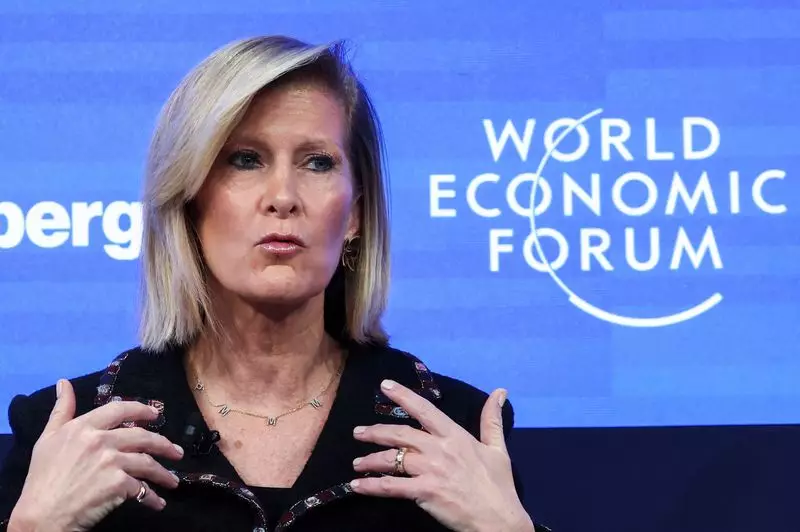As the global financial community converges on pivotal events tailored by election outcomes and new administrations, recent developments under President Donald Trump’s renewed leadership raise immediate concerns and opportunities. The rapid overturning of numerous executive orders set forth by his predecessor, Joe Biden, particularly on his inauguration day, has stirred both apprehension and strategic recalibrations among financial institutions. JPMorgan Chase & Co. exemplifies this proactive approach, mobilizing their resources to grapple with and analyze the rapidly shifting landscape.
In an unexpected but all too familiar maneuver, JPMorgan Chase established a dedicated “war room” following inauguration day. Head of Asset and Wealth Management, Mary Callahan Erdoes, emphasized the urgency, noting that teams had been working tirelessly throughout the night to consider the ramifications of Trump’s first-set executive decisions. This intense focus mirrors the pressures faced by global traders as they endeavor to interpret the broader impacts of “America First” policies on asset values.
The decision to swiftly reevaluate trading strategies reflects a broader anxiety where market participants must anticipate the potential for heightened volatility. The immediate implications felt in currency fluctuations, such as the dramatic dip of the Canadian dollar in reaction to proposed tariffs, underscore the delicate balance brokers must maintain while navigating the tumultuous waters of political decision-making. The landscape post-election becomes a living puzzle, where each executive move invites a complex interplay of risks and rewards.
As Trump’s administration prepares to roll out policies that affect international trade, global economic interactions are positioned for unexpected ripples. The forecast of new tariffs and regulatory overhauls fundamentally influences global supply chains and economic cooperation. During the World Economic Forum, Standard Chartered CEO Bill Winters articulated these imminent challenges, suggesting that China and its substantial export surplus could soon face renewed aggressions, creating friction in a historically fragile trade dynamic.
China’s apprehension regarding potential trade wars underscores the tension within international relationships that were fraught during Trump’s previous term. They are acutely aware of the challenges posed by the unpredictable tariff threats made during his campaign, highlighting the fragility of the current global trade framework. Trump’s keen focus on domestic production and self-reliance may offer comfort to some sectors within the U.S., but will likely incite a host of retaliatory measures, ultimately reshaping global market fundamentals.
The sudden shifts in policies are further complicated by the existing regulatory environment that many banking executives deem as hindering robust growth. Robin Vince, the CEO of BNY, articulated a resounding critique of current regulations, positioning them contrary to the overarching goal of enabling economic expansion. His sentiments resonate with an emerging consensus among financial leaders at the World Economic Forum who argue for regulatory reform that prioritizes growth over merely containing risk.
In light of these discussions, a spotlight falls on the proposed delays in stricter bank capital rules by institutions like the Bank of England, a delay sparked by the uncertainty surrounding Trump’s policy directions. The broader implications may not only affect lending practices but also the global banking landscape’s competitive dynamics. The interest in revisiting these guidelines aligns with calls for a regulatory environment that fosters growth, rather than stifling it amidst existing cautionary measures.
As European leaders express their desire to recalibrate regulatory frameworks, executives like Ana Botin from Santander advocate for a pause on new regulations to allow for introspection on what truly contributes to sustainable and innovative economic growth. This call for re-evaluation echoes through the corridors of international finance as leaders realize that aligning regulatory objectives with practical economic outcomes is crucial.
The juxtaposition of different regulatory environments between Europe and the U.S. further complicates global standards and practices. With the overarching goal of facilitating growth, it is essential for international financial bodies to unify their approaches to regulation, ensuring that they do not inadvertently stymie innovation and competitiveness in an increasingly interconnected world.
Ultimately, as the financial world adjusts to the realities of a Trump presidency, the convergence of policy shifts, taxation changes, and evolving regulations prompts a mixed bag of challenges and opportunities. Financial institutions and global markets must unveil a strategic clarity that enables them to thrive within this evolving framework. The journey ahead may be fraught with unpredictability; however, it is also a chance to redefine resilience and adaptability in global finance.

